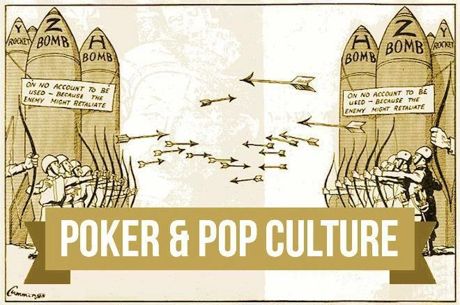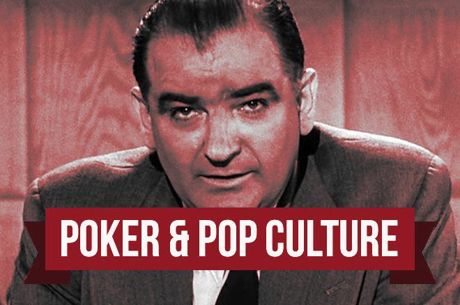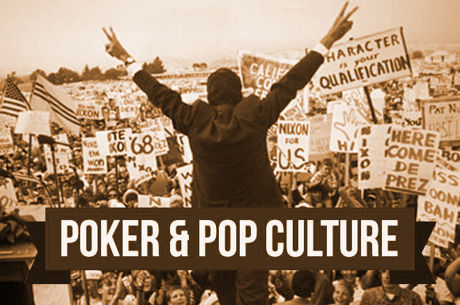Poker & Pop Culture: Explaining How 'Poker Is Like Life'
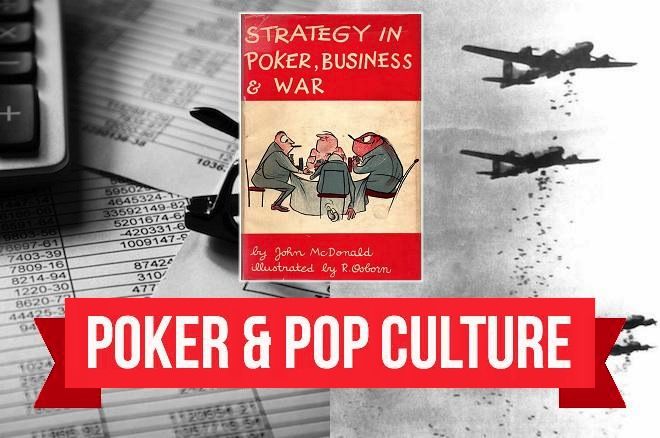
Once upon a time I would get more annoyed than I probably should have whenever I heard someone utter the cliché "poker is like life."
I wasn't bothered by the idea of comparing poker to other "non-poker" parts of our existence. Indeed, that's one of the great pleasures of the game, I'd say — the way poker's intellectual challenges, emotion-affecting swings, and social exchanges tend to echo "real life" in interesting, sometimes genuinely revealing ways.
What I minded, rather, was insufficient elaboration following the declaration. How is poker "like life," I'd want to know. And if the subsequent explanation didn't go much further than "you have to play the hand your dealt," well, I'd often be left wanting more.
By the mid-20th century, poker had become popular enough in America to inspire many to consider how the game was "like life" in the post-war United States — specifically how game play and poker strategy could be said to reflect certain aspects of capitalist culture, among other "American" ideas and values.
One such thinker was John McDonald, whose 1950 book Strategy in Poker, Business & War provides what is still a smart and engaging read for those curious to know just how exactly our favorite card game parallels other aspects of the cultures in which we live.
Explaining Ways "Poker Is Like Life"
By the middle of the century, bridge continued to be the country's most popular card game, with the rummy-variant Canasta then enjoying a surge causing it to challenge for the top spot. But poker was gaining as well. A survey conducted by the Association of American Card Manufacturers in 1940 showed bridge to be the most popular game among both men and women, with poker having already moved up to second on the list for men.
Following World War II, John McDonald — not to be confused with the similarly-named hard-boiled writer John D. MacDonald whose Travis McGee novels often featured poker — was a staff writer for Fortune magazine. He contributed numerous articles about business and the economy while occasionally also weighing in on other favorite topics like horse racing and fly-fishing.
Like many other Americans, poker had captured McDonald's interest, too, and after penning a couple of articles highlighting ways poker mimicked American capitalism he eventually spun his study into a slim volume, Strategy in Poker, Business & War.
A primary goal of the book is to explain to a wide audience the relatively new field of "game theory," in particular presenting the findings of John von Neumann and Oskar Morgenstern in their groundbreaking 1944 book Theory of Games and Economic Behavior. The pair's work had already proven influential during and after the war, and would continue to be important as the Cold War emerged and evolved, with McDonald's book drawing even more attention to their significance.
The book also serves a second purpose, namely, to promote poker not just as an interesting, worthwhile recreation for the intellectually inclined, but a genuine source of knowledge applicable to "life," generally speaking. As McDonald explains, game theory provides the link between poker and other strategy-filled areas of our existence like business, politics, military conflict and war.
Poker: "A Laboratory of Man's Experience"
The book compiles four essays, illustrated playfully with cartoons by the famous satirist Robert Osborn. The first focuses directly on poker as an ideal game to study in order to advance the burgeoning field of game theory. Poker "is a kind of laboratory of man's experience... the laboratory of capitalism, and of socialism too for that matter," McDonald maintains.
The first poker-centric essay includes much that would interest players, including a review of the game's origins and history, an argument for money being an essential component ("any false stake is ruinous to the game") and persuasive demonstrations of poker's centrality to American culture in particular.
Most importantly, McDonald distinguishes poker from other gambling games (like roulette) thanks to the way it significantly demands skillful play and not wholly reliant on luck.
"A knowledge of mathematical probabilities will not make a good poker player," he notes, "but a total disregard for them will make a bad one." And, of course, the importance of bluffing to the game — "the spirit of poker," says McDonald — functions to "create uncertainty between the players" and heighten the need for "shrewdness, cunning, deception, conscious strategies, suspicious appraisals of worth and character, and bold aggressions" in order to succeed.
Such qualities make poker "a travesty on life," says McDonald with some humor, ensuring that "all of the repressed values of a competitive society are let loose and placed first in the order of proprieties."
Even so, that's precisely what makes poker such a good "laboratory" in which to study that very society and the interactions of those who inhabit it.
Presenting a Theory of Games
The second essay attempts to present game theory, as introduced a few years before by von Neumann and Morgenstern, in a way that laypersons can follow and appreciate.
McDonald summarizes the steps taken toward the creation of "a new mathematical approach to economics" (the "first aim" of von Neumann and Morgenstern). They had begun making a distinction between purely chance-based games like solitaire, and "strategical games" like matching pennies. The latter "introduces the first important strategical element in the theory of games, namely, random choice" — that is, a method for the player of the game to "avoid knowing his own pattern" and thus avoid being exploited by an observant opponent.
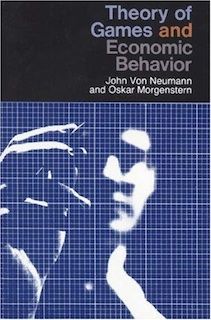
From there other games are considered, with bridge and poker emerging as the best models since they contain "the full complement of game elements: choice, interdependence, imperfect information, and chance." Poker then wins out as "the ideal model of the basic strategical problem" thanks to the strategic importance of bluffing, a deceitful move rational players understand needs to be performed sometimes in order to get opponents to fold better hands and to call with weaker ones.
Along the way, McDonald explains the important concept of "minimax" first articulated by von Neumann in the 1928 essay that had initiated the work resulting in the later book with Morgenstern. "Minimax" refers to a decision-making strategy that employs logic to maximize the minimum expected gains and to minimize the maximum expected losses. At the time the theorem was "one of the most talked-about novelties in learned circles today" reports McDonald, an "optimum strategy" whereby players can make decisions pushing them toward a less random, "known probable average outcome[s]."
A simplified two-man poker game presents a situation of opposing interests that translates well to other, non-poker forms of competition and conflict. From there three-man games are considered, as is the idea of two of the three players ganging up on the third — a kind of collusion theoretically not permitted in poker, but needful to consider when applying such theories to "real life."
Business and the Game of the Marketplace
The third essay focuses on the "game" of business, starting with the buyer-seller relationship that can in many ways be said to parallel the situation of the two-man poker game. You've heard such analogies before, no doubt, such as when players talk about bet-sizing strategy and the importance of finding just the right amount to elicit the desired response of a call if value betting, or a fold if bluffing.
McDonald here shows the limitations of the poker analogy, since so often in business there exist oligopolies or monopolies — that is to say, situations in which some "players" in the "game" exert more influence than others, in effect distorting the rules. Coalitions are also frequently formed, requiring the creation of other models than one based on a game like poker in which such "teaming up" isn't typically allowed.
The immense complexity of the marketplace is also acknowledged, despite the fact that it often happens within particular industries that a couple of major "players" will emerge to fight out a version of a "two-man game" for leadership. Even so, by having addressed coalitions game theory has (by then) helped shed light on both oligopoly and so-called "monopolistic competition" that had "long baffled economic thought," notes McDonald.
Politics and War Games
The fourth and final essay briefly looks at both political and military "games." Political conflicts McDonald characterizes as usually resembling "coalition games," that is, the three-man games in which the creation of strategically beneficial coalitions alter the balance of power.
For an example he cites Democratic and Republican conventions, which at the time of his writing could reasonably be characterized as tending to resolve into "invariably at least a three-man game." Such is not so much the case today, of course, as the most recent conventions in 2016 — and primary campaigns — operated more like two-person games between frontrunners (Hillary Clinton and Donald Trump) and a single challengers (Bernie Sanders on the Democrats' side, and an ultimately ineffectual coalition of "never Trumpers" on the other).
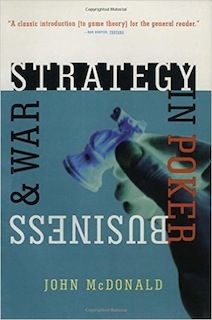
McDonald also characterizes the rise to power of Joseph Stalin in the Soviet Union and of Adolf Hitler in Germany as resulting from "coalition games," with World War II similarly featuring an initial coalition between those two ultimately broken off with Stalin then joining the Allies. Franklin Delano Roosevelt and Winston Churchill, recognizing the importance of the coalition, made concessions to Stalin (right through the war's conclusion) in order to prevent his defection and maintain the Allies' stability.
Military conflicts, meanwhile, are even more ably expressed and guided by game theory, McDonald explains, arguing that "in military affairs the theory of games is more highly developed and exact." Since most "military problems are two-person games" — like a duel — the findings of the game theorists can be more readily applied. That said, even if particular battles and isolated engagements between opposing forces can be so analyzed, McDonald believes larger wars between nations likely cannot.
"War is a kind of experiment," he explains, "a test that generally would not be made if the opposing forces could measure accurately one another's strength. Unless there is a great disparity in the sides, the possibility of such measuring [provided by game theory] seems like daydreaming."
Conclusion
A contemporary review of McDonald's book praised his attempt to present the new theory to a wide audience, though censured the author for having jumped into practical applications — business, politics, military conflict, war — without having adequately presented von Neumann and Morgenstern's findings. Says the reviewer, McDonald "seems to have assumed that any reader confronted with a simple matrix, instead of with imaginative and witty pen drawings, would close the book and flee in panic."
The reviewer might be right. McDonald's presentation of game theory only really works as an introduction to the discipline, with those desiring a more thorough and rigorous understanding needing to look elsewhere.
However for those curious about poker's rising popularity and the different ways the game had begun to be regarded by mid-20th century — including its emergence as a source of information and evidence inspiring genuine academic inquiry — the book is inarguably an important contribution.
It also provides a lot to think about for those looking for ways to elaborate on the much-shared idea that "poker is like life."
From the forthcoming "Poker & Pop Culture: Telling the Story of America's Favorite Card Game." Martin Harris teaches a course in "Poker in American Film and Culture" in the American Studies program at UNC-Charlotte.
Images (top): "Numbers and Finance" (adapted), Ken Teegardin, CC BY-SA 2.0; "B-29s dropping bombs on a Japanese city" (adapted), public domain.

